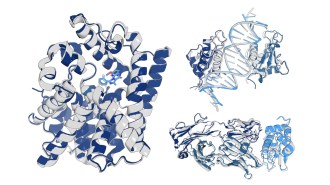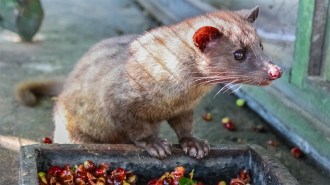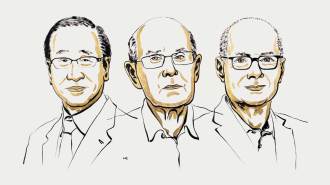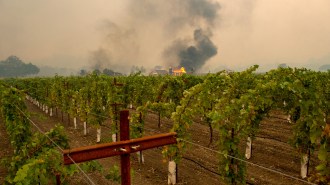Work on protein structure and design wins the 2024 chemistry Nobel
Proteins drive much of the chemistry underlying all life on Earth
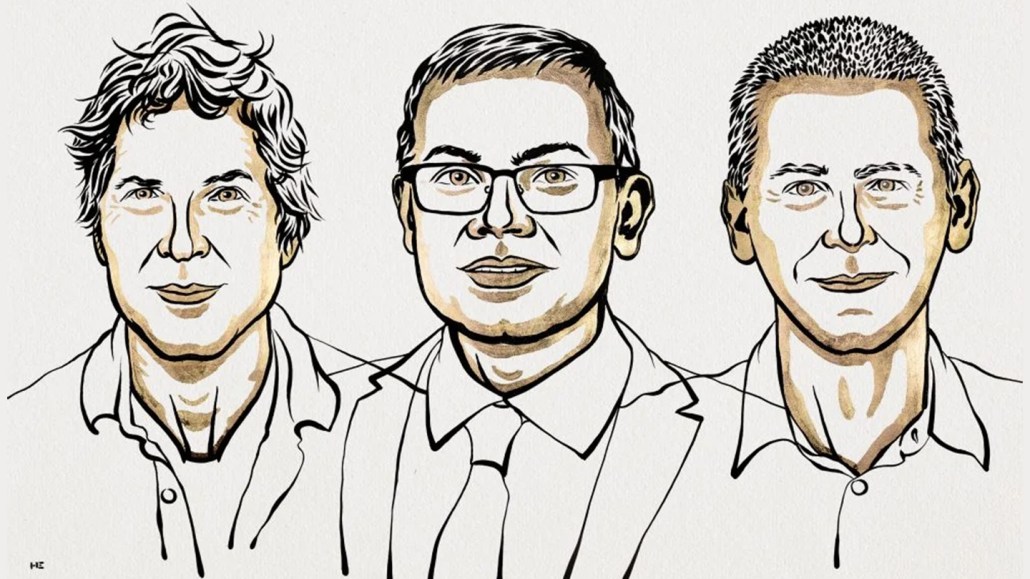
David Baker (left) figured out how to build new proteins. Demis Hassabis (middle) and John Jumper (right) developed an AI tool to predict protein structures.
Niklas Elmehed, © Nobel Prize Outreach
Efforts to unlock the mysteries of proteins, building blocks of life, have earned three scientists the 2024 Nobel Prize in chemistry.
The prize goes to David Baker “for computational protein design,” and to Demis Hassabis and John Jumper “for protein structure prediction,” the Royal Swedish Academy of Sciences announced October 9 in a news conference in Stockholm.
Proteins enable nearly every facet of life. They build our bones, skin and hair; they carry cargo from cell to cell; they are antibodies that target dangerous microbes; they are molecular machines that fix damaged DNA. Their list of roles in the body is nearly endless.
Each protein is made of a string of molecules called amino acids. Fold the string up, and you’ve got a protein. But how the string folds is key. It can pleat like a paper fan, bend into spirals, crumple up like a piece of paper and more. There’s a universe of potential shapes that depend on the order of amino acids in the string.
And just like the shape of a key determines which lock it can open, the shape of a protein influences its role in the body. “In order to understand how proteins work, you need to know what they look like,” Johan Åqvist, a member of the Nobel Committee for Chemistry, said during the news conference. “That’s what this year’s laureates have done.”
In 1998, David Baker, a biochemist at the University of Washington in Seattle, and his colleagues debuted a computer program called Rosetta that could take a short amino acid sequence and predict what the resulting protein’s 3-D structure would look like. But the real breakthrough came in 2003 when Baker’s team flipped that idea around. They sketched out a made-up 3-D protein — something that did not exist in nature — and asked Rosetta to come up with an amino acid sequence that would fold into that structure.
It worked. When Baker’s team synthesized the amino acid sequence in the lab, it folded into a protein just like the one Rosetta had predicted. Since then, Baker has created a trove of designer proteins, including one that can sense fentanyl in the environment and another that blocks the coronavirus.
“David Baker opened up a completely new world of protein structures that we had never seen before,” Åqvist said. “It’s almost as if only your imagination sets the limit for what you can do.”
Neuroscientist Leslie Vosshall says she’s used Rosetta in her own lab at Rockefeller University in New York City. “These software algorithms have accelerated the ability of all scientists to do their work,” she says. “What used to take decades or forever can now take a minute.” Vosshall is also vice president of the Howard Hughes Medical Institute, for which Baker is an investigator.
Demis Hassabis and John Jumper’s share of the prize comes from advances in protein structure prediction. In 2016, the computer scientists, both at Google’s DeepMind in London, had already gained fame worldwide for creating a computer program that beat the reigning world champion at the strategy game Go (SN: 3/15/16).
Two years later, they used their artificial intelligence chops to solve an even trickier problem. The duo’s AI model, called AlphaFold, could predict protein structures from amino acid sequences with almost 60 percent accuracy — much higher than what had been previously achieved.
That was already a step forward, said Åqvist, but a second version of the model, AlphaFold2, was even better. It could deliver results nearly as well as the gold standard method for figuring out protein structures, a laboratory technique called X-ray crystallography.
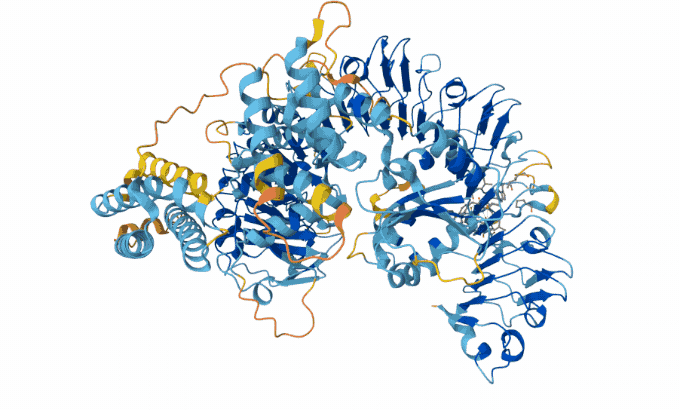
Hassabis and Jumper’s AI model taps into a database of known protein sequences and structures. It uses that info to map the likely physical distance between individual amino acids in a given sequence, then converts the map into a three-dimensional structure — with 90 percent accuracy, Åqvist said. “Protein structure prediction with AlphaFold2 caused a complete revolution in structural biochemistry.”
The AlphaFold team has now predicted structures for almost all the 200 million proteins scientists know today (SN: 9/23/22). Biologists have used AlphaFold to predict proteins in sea cucumber genomes and proteins in honeybees that protect against bacterial infections (SN: 4/10/23, SN: 12/21/22).
This is the second Nobel Prize this year that recognizes AI. The physics prize was awarded on October 8 to John Hopfield and Geoffrey Hinton, who did foundational work on artificial neural networks (SN: 10/8/24).
“It’s really interesting how well this aligns with the physics prize,” says Mary K. Carroll, president of the American Chemical Society. “The fact that neural networks were used by Hassabis and Jumper is another example of how computational and mathematical tools inform and underlie a lot of really exciting scientific work.”
Computer scientist Virginia Dignum echoes that sentiment. “What we are seeing is a triumph of interdisciplinarity,” says Dignum, director for the AI Policy Lab at Umeå University in Sweden. “The real breakthroughs in science are no longer the domain of a single discipline but require a broad perspective and the combination of different insights. AI is here an accelerator and a support for the exploration of great spaces of research.”
Baker was sleeping when the call from the Nobel committee came early this morning. When he got the news, he remembers, his wife began screaming so loudly he couldn’t hear the person on the other end of the line. “It was very, very exciting,” he said by phone during the news conference. “It’s turning out to be quite a unique, special day.”
The total prize of 11 million Swedish kronor, or roughly $1 million, will be divided between the three laureates. Baker will receive half, and Hassabis and Jumper will split the rest.
Staff writer Lisa Grossman contributed to this story.


